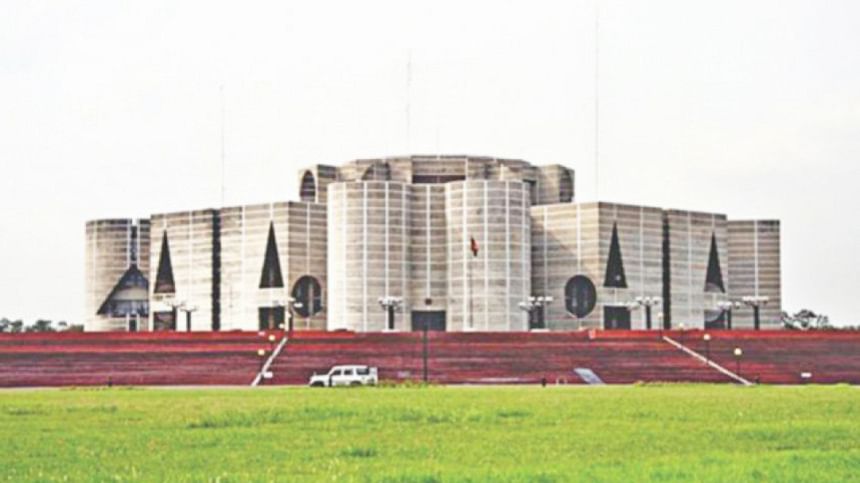So, what’s a bicameral parliament?

Simply put, a two-house parliament provides for better checks and balances, through more discussions and debates.
A bicameral parliament, one of the novel constitutional reform proposals, has two chambers -- an upper house and a lower house.
A bicameral system can ensure representation of diverse groups more effectively
However, this system can slow down decision-making as a bill needs approval from both houses. Typically, it increases public expenditure also since two houses increase administrative and operational expenses. Also, an unelected or indirectly elected upper house member may not be as accountable as the lower house members.
Currently, Bangladesh has a unicameral parliament with 350 seats, including 50 reserved seats for women.
Ali Riaz, the constitution reform commission chair, told The Daily Star yesterday that they proposed a bicameral parliament, increasing the number of seats in the lower house to 400 and adding another 105 seats for a newly constituted upper house.
Out of the 400 seats in the lower house, 100 will be allocated to women who, like their male counterparts, will be directly elected.
Upper house members will be determined through a proportional representation system. Political parties will be allocated seats in the upper house based on their proportion of votes in general elections, said Ali Riaz.
There will also be provisions to ensure representation for minorities and various ethnic groups, in the upper house. The political parties will be required to include at least five members from marginalised groups among the 100 upper house members. The commission chief explained he had proposed that the president would nominate another five from among the citizens who do not belong to any political party.
Al Masud Hasanuzzaman, a professor of government and politics at the Jahangirnagar University, told The Daily Star that he endorsed a bicameral legislative system. He said there were 300 seats when there were 70 million people in Bangladesh around the time of independence, which has now grown to more than 180 million.
"A bicameral legislature creates a system of checks and balances between the two houses," he said.
"It is yet to be decided whether representation in the upper house will be based on profession or follow some other approach. We have proposed a division-based representation," he said.
Political analyst Tofail Ahmed in his book "Sangskar Sanglap: Suchana Sutra," said that 87 out of 192 countries have bicameral legislation system. In South Asia, India, Bhutan, Pakistan and Nepal have bicameral legislative systems.
Tofail says that the positive side of the bicameral parliament is that a single leader or party cannot turn a bill into a law in a single day without a thorough discussion or debate. If there are two chambers, discussion in both houses becomes essential, providing time for deliberation and opportunity to discuss different aspects of a single issue.
Usually field-level political leaders remain in the lower house while the more senior and seasoned leaders along with professionally experienced people are in the upper house.
Former prime ministers, ministers, opposition party leaders as well as lawyers, judges, teachers, writers, intellectuals, members from various professions, can contribute constructively by participating in parliamentary activities, Tofail writes.
Nepal's lower house Pratinidhi Sabha (house of representatives), have 275 directly elected members and the upper house Rashtriya Sabha (national assembly) have 59 members.
In Nepal's upper house, 56 members—8 each from seven provinces—are elected by an electoral college comprising members of the provincial assembly, village councils and municipal councils. The eight members of each province include at least three women, one Dalit, and one person with disability or a minority group representative.
Three members, including at least one woman, are appointed by the president on government recommendation. The tenure of members is usually six years, with a third of the seats going into election every two years.
India's lower house, the Lok Sabha, comprises 545 directly elected lawmakers. Of them two members of the Anglo-Indian community are nominated by the president.
The upper house, Rajya Sabha, consists of 245 members. Of them 233 are indirectly elected by the state legislatures and union territories while the remaining 12 are nominated by the president. One-third of the membership is renewed every 2 years.
In the United Kingdom, the House of Commons, which is the lower chamber, has 650 directly elected members.
The upper chamber, House of Lords, has no restriction on the number of members. In practice, the upper limit has been around 800 members.
Of them, 676 life peers are appointed by the crown with advice from the prime minister; 90 are hereditary peers; and 25 are archbishops and bishops.
In the United States, House of Representatives is the lower house with 435 members directly elected by the people. The Senate, which is the upper house, has 100 members elected directly with a third of the membership going for election every 2 years.

 For all latest news, follow The Daily Star's Google News channel.
For all latest news, follow The Daily Star's Google News channel. 



Comments